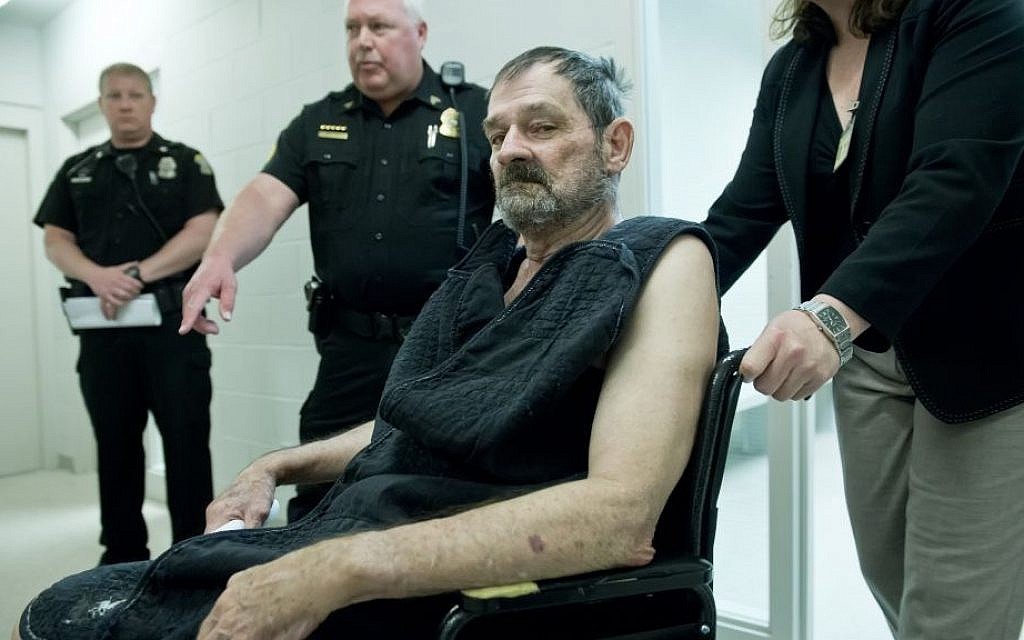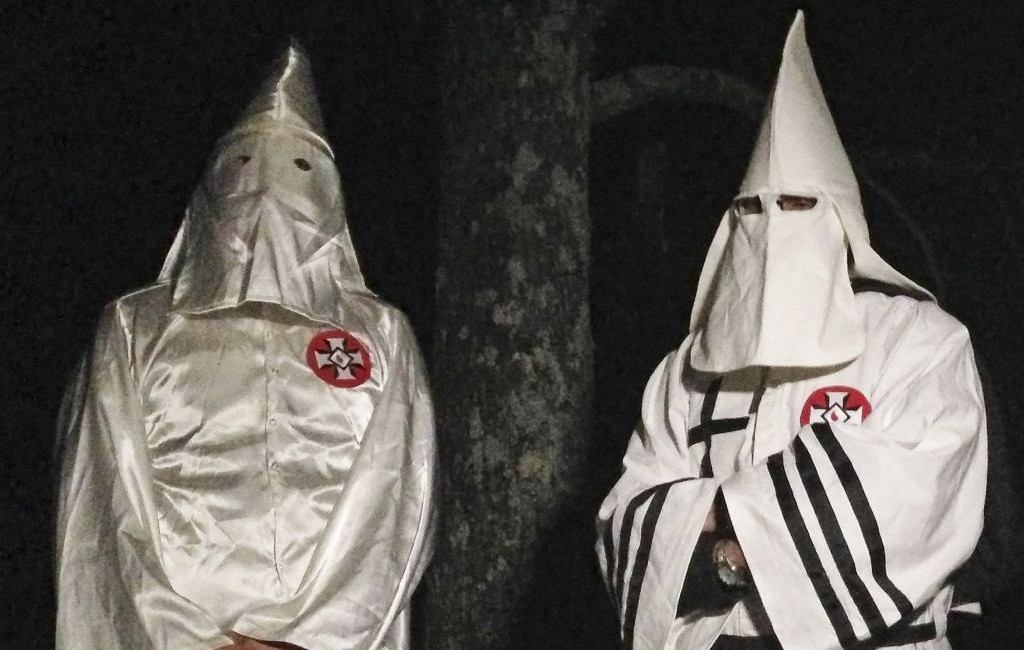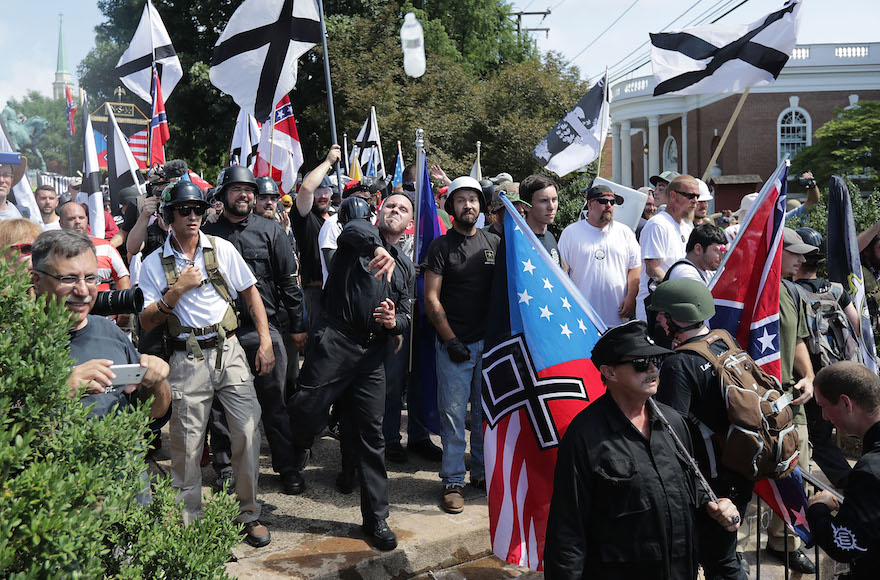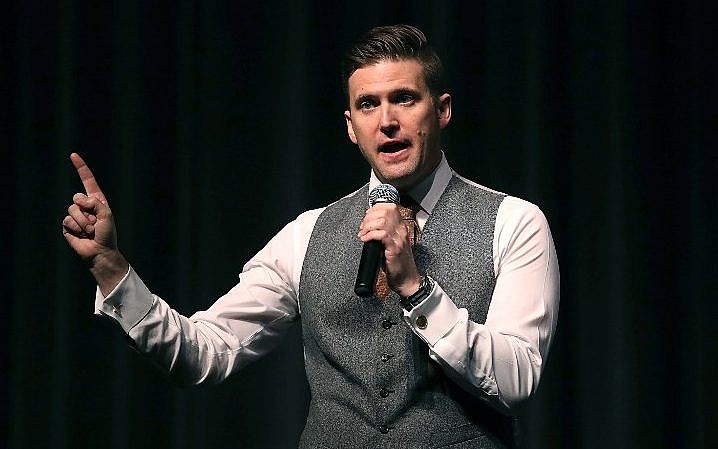Jews worry US focus on Islamic terror a way to avoid home-grown white supremacy
Today’s right-wing violence wormed its way into America’s underbelly already 25 years ago, according to a new, comprehensive ADL report

NEW YORK — In January 2009, Keith Luke walked out the door of his Boston area home with murder on his mind. The white supremacist raped and shot an African immigrant, then shot and killed her 20-year-old sister.
Next he killed a 72-year-old homeless man, also an African immigrant. He was arrested before he could carry out his stated plan to kill as many Jews as possible at a local synagogue which was hosting a weekly bingo night.
Convicted of murder, Luke, who had carved a swastika into his forehead, committed suicide in prison in 2013.
In August 2012 white supremacist Wayne Michael Page shot and killed six worshipers and injured three others at a Sikh temple in Oak Creek, Wisconsin, before being shot by police.
It is right-wing extremists such as Luke and Page who commit the most murders of any domestic extremist movement in the United States, according to a newly released Anti-Defamation League report “Murder and Extremism in the United States in 2017.” Additionally, a second new report published this week by the ADL’s Center on Extremism shows a sharp uptick in white supremacist propaganda on US college campuses during the fall 2017 semester. There were 147 incidents in 2017, compared with 41 in 2016 — a 258 percent increase.

In the last decade alone white supremacists committed 274, or 71%, of the 387 total extremist-related killings. By comparison, Islamist extremists committed 26% of killings and left-wing extremists committed 3%.
“It’s true that much of the public discussion has focused on foreign terrorism and less attention has been paid on white supremacists. One of our efforts is to remind everybody of the realities of the threat and that we don’t have the luxury to focus on one threat over another,” said Oren Segal, director of the ADL’s Center on Extremism.
And while Donald Trump’s campaign and election, as well as Heather Heyer’s August 2017 murder by white supremacist James Alex Fields, Jr., brought the issue to the forefront, the numbers started climbing a quarter century ago.
As the ADL’s report, “A Dark and Constant Rage: 25 Years of Right-Wing Terrorism in the United States” notes, today’s right-wing violence wormed its way into America’s underbelly long ago.

“The report is deeply concerning, but sadly it’s not surprising. This is the reality faced by many communities across the country — Jewish, Muslim, Sikh. So it’s galvanized not just the Jewish community and it shows we all need to be re-engaged with this issue,” said Barbara Weinstein, associate director for the Religious Action Center of Reform Judaism.
The statistics are concerning for those Jewish organizations whose mission is combating racism, anti-Semitism and xenophobia. But of more concern is the view that they lack a partner in the White House for combating this scourge. Instead, organizations such as the non-partisan National Council for Jewish Women said they find the actions and policies of the year-old administration bolster white supremacists.
“We have a very big problem. We are going backwards when I thought we’d be going forwards,” said Nancy J. Kaufman, chief executive officer of NCJW.
“It’s trickling down in a terrible way. What we thought was taboo has become acceptable. White supremacists standing in front of synagogues, cemeteries vandalized; it’s all quite shocking. When you let the genie out of the bottle, anything is possible. It’s very troubling. I don’t think we’ve seen it this bad since the height of the KKK, and it’s something we are doing our best to fight against,” Kaufman said.

The group, which was founded in 1893, spoke out against former White House Chief Strategist Steve Bannon and is now crafting a statement against senior advisor Stephen Miller, who is Jewish. Kaufman said Miller is someone whose immigration views can only be described as those of a white supremacist.
White identity politics played a significant part of Trump’s campaign, according to fivethirtyeight.com.
In rallies and speeches the future president frequently highlighted crime, immigration and Islamic terrorism. It was a strategy that appealed to those in extreme right groups.
Last year white supremacists held at least three dozen rallies in the nation. It was also a year where white supremacist murders jumped 20% from 2016, making it the fifth deadliest year for extremist violence since 1970, according to the ADL.
Absent a partner at 1600 Pennsylvania Avenue, Kaufman said NCJW is working closely with local officials and various other groups such as HIAS and Workmen’s Circle, a progressive Jewish group.
It also recently announced its partnership with Communities Against Hate, a coalition of civil rights organizations including the Lawyers’ Committee for Human Rights, Asian Americans Advancing Justice, and the Religious Action Center of Reform Judaism. The coalition documents and records hate incidents as they occur.
Government efforts to track domestic terror
Soon after his inauguration, word spread that Trump planned to revamp the Department of Homeland Security’s Countering Violent Extremism program to focus solely on Islamic terror.
However, the program isn’t the only federal counter-terrorism program. The FBI’s Terrorist Screening Center continues to track domestic terrorists, and specifically includes white supremacist groups on their website.
With regard to the FBI’s Domestic Terrorism investigative program, the threat of domestic terrorism remains a priority for the FBI. It is important to note that the FBI cannot initiate an investigation based solely on an individual’s race, ethnicity, national origin, religion, or the exercise of First Amendment rights.
“Domestic terrorism groups differ from traditional criminal groups in that they take action for a different purpose, to bring attention to a social or political cause,” Andrew C. Ames, of the FBI’s national press office told The Times of Israel in an email.
“Therefore, their existence as a group has a legitimate purpose, at least in part. Their legitimate activity may include acts of protest, advocacy, and civil disobedience,” he said.
Ames said that the FBI’s domestic terrorism program identifies “nine persistent extremist movements in the US: white supremacy, black identities, militia, sovereign citizens, anarchists, abortion, animal rights, environmental rights, and Puerto Rican Nationalism.”
Still, the Trump administration has curbed other efforts to thwart violent domestic extremism.
Towards the end of former president Barack Obama’s tenure, his administration granted the Department of Homeland Security $400,000 for Life After Hate, a nonprofit founded by Christian Picciolini dedicated to helping right-wing extremists leave radical groups.

Five months after Trump took office, his administration withdrew its funding. Based in part on the funding changes to his organization, Picciolini says white supremacist terrorism isn’t getting the requisite attention.
“We still are not calling violent white supremacist acts terrorism. We still don’t have domestic terrorism statutes in the books. In fact, several states don’t even have hate crime laws,” said Picciolini, the author of “White American Youth: My Descent into America’s Most Violent Hate Movement-and How I got Out.”
“Even though the effects of white supremacist terrorism are constantly rearing their ugly head, it goes under-reported, unclassified, and largely unopposed by the Trump administration and federal law enforcement,” he said.
Nevertheless, the shift of resources away from fighting domestic extremist groups towards fighting extremist Islamic groups actually began in 2001 after the 9/11 terror attacks, according to a 2012 report by Arie Perliger for the Combating Terrorism Center at West Point.
This occurred even as there were a “dramatic rise in the number of attacks and violent plots originating from individuals and groups who self-identify with the far-right of American politics,” according to the report.
Prior to the Perliger report, there was the 2009 DHS report “Rightwing Extremism: Current Economic and Political Climate Fueling Resurgence in Radicalization and Recruitment.” One of the report’s key findings was the increased use of social media by right wing extremists to “further radicalize those already subscribing to extremist beliefs.”

“I think there was a lot happening beneath the surface. I doubt many American Jews had even heard of the alt-right a year or so ago,” said David Bernstein, executive director Jewish Council for Public Affairs (JCPA).
“I think only now are we recognizing it as a significant threat and that it is getting broad recognition in the Jewish community,” he said.
While Bernstein and others would like to see the Trump White House take a stronger stance, they aren’t waiting with bated breath.
“Like many others we were disappointed with the president’s remarks in the wake of Charlottesville,” he said, referring to Trump’s remarks that the white supremacists who protested in Charlottesville, Virginia, included “some very fine people.”
Calling out hatred
As Weinstein of RAC said, the problem can’t be correctly addressed if there is a refusal to name the problem.
“One effect of that is that it gives comfort to those that should be ostracized and denounced. Leadership needs to come from the top. It is concerning that there hasn’t been a clear and message from the [White House] denouncing white supremacy,” Weinstein said, adding RAC will continue to work with local police and FBI on instituting best practices when it comes to fighting right-wing extremism.
And while an Islamic extremist committed the single deadliest incident last year — the murder of eight people on a Manhattan bike path — right-wing extremists, primarily white supremacists, committed most of the 2017 hate-related murders. Additionally, US citizens committed many of the terror incidents inspired by ISIS or other extremists groups.

Yet, according to an article on fact-checking website politifact.com, the current administration consistently highlights cases where immigrants who entered the country through the diversity visa lottery or other immigration programs are directly linked to terror plots. The article claimed the administration is misleading the public in regard to foreign versus domestic terror.
‘Growing radical ideology’
Last May, the ADL’s director and CEO Jonathan Greenblatt testified before the Judiciary Committee Hearing on Responses to Increase in Religious Hate Crimes.
While applauding the US Justice Department for creating a Hate Crime Subcommittee within the Attorney General’s Task Force on Crime Reduction and Public Safety, Greenblatt also called for a task force to coordinate hate crime responses across the Executive Branch.
Looking ahead, the ADL, NCJW, RAC and others in the Jewish institutional world’s alphabet soup, are pushing the federal government to enact into law the NO HATE Act. They also aim to pass an amendment to the Church Arson Prevention Act, secure congressional passage of the Anti-Semitism Awareness Act, and strengthen existing hate crimes laws.
As for JCPA, it will continue to partner with local law enforcement and elected officials as well as other Jewish organizations within its network, such as Hillel International, to develop and share security resources.
Bernstein also said JCPA will continue to work with other ethnic and religious groups on the local level so they can prepare themselves for anything that might happen, such as white supremacist Richard Spencer’s plans to host events this spring on college campuses. He is scheduled to speak at Michigan State University in March and is trying to hold an event at Kent State University on May 4, marking the 48th anniversary of the killing of four students by National Guardsmen.
Off the screens and onto the streets
Many in the Jewish community said more effort is needed to study the connection between online hate and bias-motivated violence. In the past two years white supremacists have moved beyond the internet and into the real world.

“The bigger challenge is the growing radical ideology being fostered on social media. In the past couple of years we saw Twitter campaigns and we saw other social media sources galvanize right-wing voices. It’s more diffuse and harder to combat but we have to do a better job of it,” JCPA’s Bernstein said.
In late December, a Virginia teenager shot and killed his girlfriend’s parents after they reportedly voiced concern about his alleged anti-Semitic and racist views.
And just last Tuesday, 19-year-old Michigan resident Brandon Griesemer was accused by the FBI of calling CNN 22 times, “railing against African-Americans and Jews and threatening a mass shooting,” according to NBC News.
“One thing people don’t understand is that most extremists in this country are unaffiliated with an actual group. They meet online and use that interaction to connect in person,” ADL Center on Extremism head Segal said.
“They believe violence is a legitimate tactic to support their ideology and that is a concern. The individual person is being radicalized online and then choosing to act on those ideas on the street,” said Segal.

Israel is now a far more prominent player on the world stage than its size suggests. As The Times of Israel's Diplomatic Correspondent, I'm well aware that Israel's security, strategy and national interests are always scrutinized and have serious implications.
It takes balance, determination, and knowledge to accurately convey Israel's story, and I come to work every day aiming to do so fully.
Financial support from readers like you allows me to travel to witness both war (I just returned from reporting in Ukraine) and the signing of historic agreements. And it enables The Times of Israel to remain the place readers across the globe turn to for accurate news about Israel's relationship with the world.
If it's important to you that independent, fact-based coverage of Israel's role in the world exists and thrives, I urge you to support our work. Will you join The Times of Israel Community today?
Thank you,
Lazar Berman, Diplomatic Correspondent

We’re really pleased that you’ve read X Times of Israel articles in the past month.
That’s why we started the Times of Israel ten years ago - to provide discerning readers like you with must-read coverage of Israel and the Jewish world.
So now we have a request. Unlike other news outlets, we haven’t put up a paywall. But as the journalism we do is costly, we invite readers for whom The Times of Israel has become important to help support our work by joining The Times of Israel Community.
For as little as $6 a month you can help support our quality journalism while enjoying The Times of Israel AD-FREE, as well as accessing exclusive content available only to Times of Israel Community members.
Thank you,
David Horovitz, Founding Editor of The Times of Israel

comments